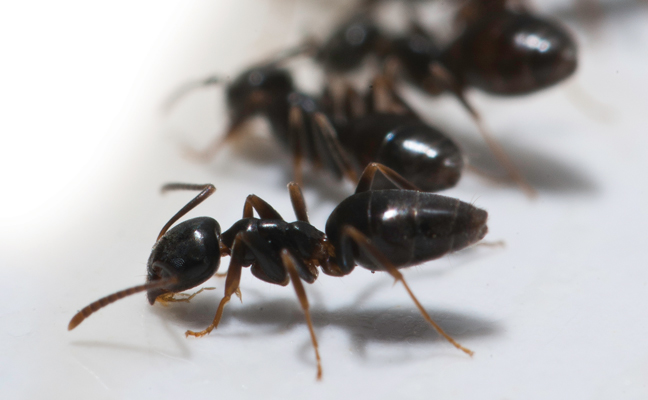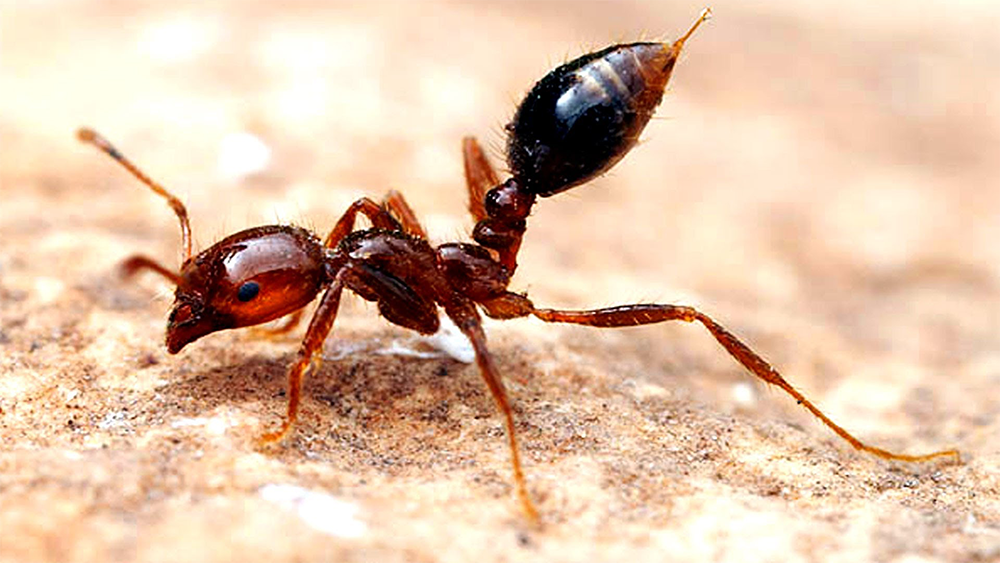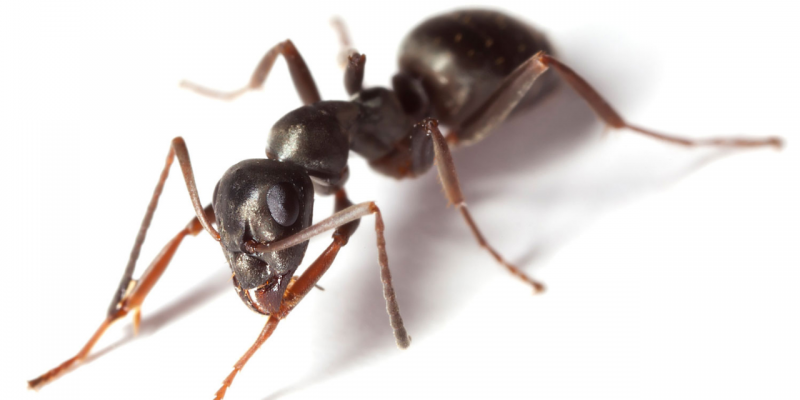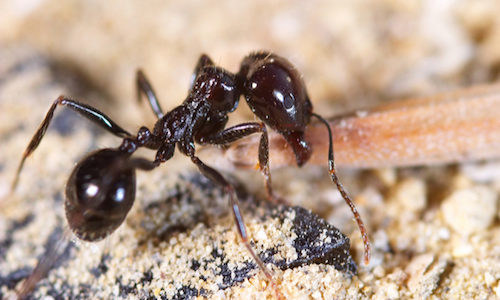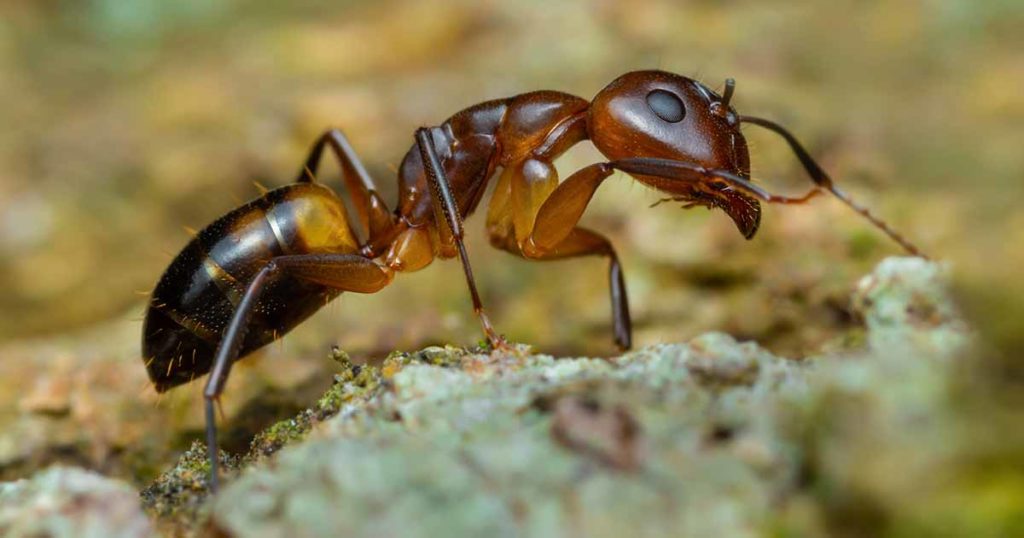So you spotted ants in your dishwasher.
What are your next steps?
The first thing you need to do is get rid of the ants inside your dishwasher, and the second step is to determine the root cause of the problem.
Why Are Ants Attracted To My Dishwasher?
Ants are attracted to dishwashers because they have two things that termites need to survive: food and water.
Inside or around the dishwasher, ants are likely to find an abundance of both food and water.
Ants will come here to forage for water and food and return it to the colony.
Leaving dirty dishes sitting in the dishwasher is sure to attract ants.
Even a clean dishwasher will attract due to the food residue found at the bottom and the leftover water inside.
How To Get Rid of Ants in Your Dishwasher?
Getting rid of the ants inside of your dishwasher is just a temporary solution but nonetheless a necessary one.
1. Remove Dirty Dishes from your Dishwasher
The first step to eliminating ants from your dishwasher is removing all the dirty dishes.
You’ll also want to avoid keeping dirty dishes inside your dishwasher for too long.
If you don’t want to run your dishwasher often, I recommend rinsing residue off of the plates.
Another thing you can do is to spray your dishwasher with a mixture of water and dishwasher detergent every time you place a dirty dish inside.
2. Clean the Bottom Of Your Dishwasher
Make sure to clean your dishwasher’s filter.
It’s common for food residue to get stuck on the filter, providing ants with plenty of food.
When your dishwasher is not running, ants may crawl into your filter to retrieve food.
Here’s how you can clean your filter:
- Twist to unlock and remove from the dishwasher.
- Remove the internal portion.
- Using water and a scrub brush remove any residue from the inside and outside parts of the filter.
- Return the filter and lock it in place.
3. Run Your Dishwasher on High
The best option is to run your dishwasher on high temperature along with a chemical inside to help eliminate the ants.
Remember don’t use insecticides inside your dishwasher.
This will contaminate your dishwasher and expose your dishes to harmful chemicals that can get on your food.
Running your dishwasher on high is not always sufficient at eliminating all ants.
This is because your dishwasher won’t drown the ants.
Ants can survive up to 24 hours submerged underwater.
Also, depending on the species of ant, they can survive temperatures between 100 and 135 degrees Fahrenheit.
Most dishwashers can reach between 120 and 145 degrees Fahrenheit.
This means some ants can survive a dishwasher on high temperature.
To combat this, you need to combine the high heat with a chemical to eliminate them.
I recommend using about 1 cup of bleach.
Bleach is a chemical that is safe to use inside your dishwasher and will kill ants on contact.
An alternative to bleach is using vinegar.
I recommend using 2 cups of white vinegar.
To clean the inside of your dishwasher, run your dishwasher on high with a dishwasher safe open cup of your preferred chemical.
This should kill most of the ants inside your dishwasher.
Even those hiding in small crevices at the bottom of the dishwasher will die once they come in contact with the chemical.
4. Clean Your House
One of the most natural things you can do to keep ants out of your house is cleaning up any food or water sources.
Be sure to clean up food preparation areas to ensure there are no potential food sources for ants.
Wipe down your counters with a cleaning agent is a great way to remove ant trail pheromones.
Clean anywhere you recently saw an ant trail to make sure they can’t use it again.
I also recommend cleaning underneath appliances where food tends to accumulate, such as the refrigerator, microwave, and stove.
It is also vital that you store food properly in airtight containers or bags, including dog food.
If you have pets, clean and store food and water bowls properly when they are not eating.
Indoor plants can also attract ants. Some of these plants are home to aphids that produce honeydew.
Indoor plants can also be home to small insects that ants feed on.
How to Get Rid of Ants Inside Your Home?
Having ants in your dishwasher doesn’t necessarily mean that you have an infection inside your home.
Ants will travel far for food. It could be that they live outside your home and are going inside your house for food.
That said, if you see ants in your dishwasher or any part of your home every day at the same time, you likely have an infestation.
To eliminate ants from the inside of your home, you will need a comprehensive approach.
Pest control services call this approach Integrated Pest Management or IPM.
Don’t let the fancy name intimidate you. IPM is something you can do on your own.
Below are the steps to eliminating ants from the inside of your home.
1. Inspect / Monitor Your Home
Inspecting and monitoring is vital for two things
- Identifying the type of ant
- Finding where they live and travel
Different species of ants feed and behave differently. As such, they should also be treated separately.
Take a photo or capture one ant in your dishwasher so you can identify later.
Next, look for other ants inside and outside your home.
If you find a trail, follow it back and try to find the source.
Fdinding the nest can also help you identify what type of ant you have
You can always just take a photo or capture one ant to compare them with the ones in your dishwasher.
One way to check if two ants belong to one nest is to capture one ant from each trail and place them in a container.
If the ants are not from the same colony, they will fight each other.
Keeping track of what food they are eating and locations they congregate is also essential in the treatment process.
Some of the best places to inspect for ants are:
- Around windows and door frames.
- Inside and around cabinets.
- Near plumbing or source of water.
- Around the perimeter and foundation of your home.
- Yeards, gardens, or piles of soil.
- Under rocks or any other objects outside.
- Near potential food sources such as inside the pantry or near dog food.
- Inside crawl spaces.
- Near plants and vegetation.
Some tools you will need to make your inspection process a bit easier are:
- Flashlight
- Metal Probe
- camera/smartphone for capturing photos
- glue boards
- hard hat for under crawl space
- extendable mirror for hard to reach areas.
Pre-Baiting
If you can’t find the ant trail, consider pre-baiting.
Pre-baiting allows you to find ant trails by placing attractive food inside and around your home.
A forager will eventually find the food and recruit other ants to gather the food.
I suggest using a 50/50 mixture of honey and water for a sugar bait.
You can also use mashed up boiled eggs and peanut butter as a protein pre-bait.
Be sure when you place these baits, they are in a shaded or cool area.
Ants do not like to forage for food in sunny or hot areas.
Make sure you check your pre-baits throughout the day.
Different ants forage at different times.
Carpenter ants, for example, only forage food at night.
While other species of ants, such as Odorous ants and Pharoah ants, are equally active during the day and night.
So, unless you know exactly what type of ant you have at this point, checking your bait multiple times is necessary.
Once you’ve found the trail, follow it to determine where they came from and how they got in—doing so will tell you where to treat the ants.
If there are multiple ant trails, follow each one.
Multiple ant trails could be a sign that there are two ants nests nearby, and you need to treat each one separately.
2. Identification
Ants are small, so figuring out what they look like can be hard.
An easier way to identify them is by examing their appearance, nest location, and food preference.
Appearance
To do this, I recommend capturing one ant and using a magnifying glass.
You can also take a photo with your smartphone zoomed in to get a closer look.
Food Preference
Different types of ants have different diets.
Some ants might prefer sweets and protein, while others might prefer oils and fats.
You can use what ants are eating or not eating to help you identify the type.
Nest Location
Following the trails to find an ant’s nest can help determine what type of ant it is.
Carpenter ants, for example, live inside the wood.
Pavement ants, on the other hand, may build their nest under concrete and come up through the cracks.
It’s not always easy to determine where an ants nest is.
If you can’t determine where the nest is, focus on the ant’s appearance and eating habits.
Common Household Ants
1. Carpenter Ants
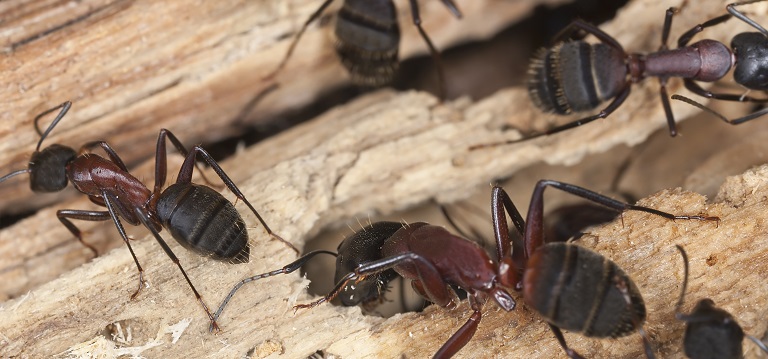
Appearance
Size: 1/4 of an inch to 5/8 of an inch.
Color: Red or Black Body
Hair: Golden hairs around the abdomen.
Food Preferences
Carpenter ants prefer sweet food as well as dead or live insects.
Since they live inside the wood, they typically consume tree or plant sap.
Nest:
Build nest inside wood such as tree stumps, firewood, fences, hollow doors, window frames, roof trim, rafters.
Typically prefers moist or damp wood because it is easier to create tunnels.
2. Odorous Ants
Appearance:
Size: 1/8 of an inch in size or less.
Color: Dark brown or black. Tends to have a shiny shimmer to its body.
Hair: Odorous ants have no hairs around the abdomen.
Food Preferences
Odorous house ants typically prefer sweets and other human food.
Will also consume live and dead insects.
Nest:
Typically found in shallow mounds in soil or debris.
They are also common in wall voids typically around sources of water, such as pipes.
3. Red Imported Fire Ant
Appearance:
Size: 1/6 of an inch to 1/3 of an inch.
Color: Bicolor- red head and thorax and brown abdomen.
Other Characteristics: No hair, three visible teeth, and 2 Nodes
Food Preferences:
Fire ants prefer sweets and protein-packed foods.
Nest:
Large dome-shaped mounds with multiple openings in sunny locations.
Typically found in soil or lawns and occasionally inside wall voids.
4. Pavement Ants
Appearance:
Size: 3/16 of an inch long, all ants the same size.
Color: Light brown to black
Other Characteristics: Two nodes, raised ridge and spine before abdomen, and stinger.
Food Preferences
Pavement ants prefer sweets, proteins, and grease.
Nest:
Nest found at ground level under sidewalks, foundations, and driveways.
Typically burrow out of cracks in the pavement.
Also common in soil, under rocks, or near water.
5. Little Black Ants:
Appearance:
Size: 1/16 of an inch long, all ants the same size.
Color: Shiny dark brown to black.
Other Characteristics: Two nodes, three-segmented clubs.
Food Preferences
Little black ants eat nearly anything from sweets, proteins to oils, including human food.
Nest:
Common to find nests both indoors and outdoors.
Outdoor nests are typically neat moist wood or bricks.
Indoor nests can be found inside wall voids, or under foundations.
6. Argentine Ants
Appearance
Size: 1/8 of an inch long.
Color: Black body with yellow mandibles.
Other Characteristics: One node, no hairs, triangular head.
Food Preferences
Typically prefers sweets but may change food preferences based on the season.
Nest
Typically found outdoors in shallow mounds.
They Can create massive supercolonies that span hundreds or even thousands of miles.
4. Use Bait Indoors and Outdoors
Ant baits are regarded as the most effective way to treat ant infestations.
Baits are a mixture of attractant and insecticide.
When a worker ant finds the bait, they take a portion of it and tell other workers to bring it back to the colony.
The ants will then place the bait in their food storage area, contaminating the rest of the food.
Eventually, the contaminated food and the bait will kill the entire colony.
The key to a successful bait strategy is using bait that ants are attracted to and placing them in the right locations.
Place ant baits in all the locations where ants were active during pre-baiting.
Doing so will make it a seamless and efficient transition once you apply the bait.
Remember to remove any pre-bait or any other food sources that might be around.
It’s best to keep the ants focused on the bait you are using with no other alternatives.
When selecting your bait, take into consideration the type of ant you identified earlier.
Not all ants are attracted to the same food.
Specific bait might attract some species of an ant while others won’t.
Outdoor Ant Bait
The best option for outdoor ant bait is using refillable ant baiting stations.
These are typically stations where you can fill a liquid or gel bait that will attract ants.
Place these stations around the perimeter of your home.
I recommend placing one along each corner or side of your home.
Other ideal places to put bait stations are near ant mounts, in your garden near plants, or near other outdoor structures.
Check your bait stations regularly to ensure that there is still bait inside.
If you notice that ants are not consuming the bait, try using a different bait to attract them.
Indoor Bait
Instant ant spray killers are ineffective at eliminating an ant colony.
The best option is to use smaller bait stations or gel bait syringes.
I prefer syringes because they are easy to apply to hard to reach locations.
They are also easy to clean up once the ants have started eating the bait.
Gel bait syringes are also a bit easier to track because you can easily see the amount of bait that ants consume.
Place indoor bait anywhere you spotted ant trails during the inspection.
Other ideal locations are:
- Under appliances
- Small cracks and crevices
- Cabinet door hinges
- Windows or door sills
- Along walls or cabinets, guides, and baseboards.
- Near sources of water
- Near ant trails
I recommend applying small daps onto 2×2 inch pieces of wax paper.
Doing so will make it easy to keep track of the bait and clean up any gel bait you apply.
3. Barrier Treatment
Another way you can eliminate the ants around your home is with a barrier treatment.
This is typically done by spraying a 3-foot wide area around the foundation of your home and 3 feet up the walls of your home.
In most cases, baiting is enough to eradicate a colony, but barrier treatments can eliminate all ants around or near your house.
There are two options when using a barrier treatment: non-repellent and repellent.
Non-Repellent Barrier Treatment
Non-repellent barrier treatments do not kill on contact.
These insecticides are slow-acting similar to baits.
When the ants come in contact with the insecticide, they will carry it back to their nest, and it will slowly kill off the colony.
This method typically takes several weeks to eliminate ants but can kill ants within a couple of days.
Non-repellent treatments are often used because they are effective at eliminating colonies.
Unfortunately, with non-repellent treatments, they will likely still enter your home, but the insecticide will eventually kill them.
If you have ants outside your home and your not sure where the nest is, then a non-repellent is the best option.
You can also spray this around the perimeter of your yard or other outdoor structures.
Any ants that come into contact with the barrier will spread the insecticide and eventually die.
Repellent Barrier Treatment
The second option for barrier treatments is repellent.
These insecticides have a high knockdown rate and typically kill on contact.
Ants are expected to die within eight hours of coming in contact with the insecticide.
Repellent barrier treatments are ideal because they will prevent ants from getting into your home.
These repellents work fast and will kill and straggling ants around your home.
Unfortunately, they are not effective against eliminating ant colonies.
4. Nest Treatment
Another common way of eliminating ants is by using a nest treatment.
Nest treatment involves using insecticide directly on the nest.
Two of the most common ways are using granules or liquid insecticide.
Granules are insecticide packed into organic matter such as sand or pebbles.
These pebbles are poured over the ant nest, followed by water to release the active ingredient inside the granules.
The insecticide will seep into the soil and kill any ants that it comes in contact with it.
You can also use a liquid insecticide for nest treatment.
Note, however, that while liquid insecticide delivers immediate results, there is a chance it won’t work for deep and large nests.
A failed nest treatment can cause ants to move to a new nest, queen ants to produce more eggs in a panic, and alates to leave the nest and create a new colony.
5. Prevention
We’ve all heard the maxim: prevention is better than cure. And when it comes to ants, this is undoubtedly true.
Here are some of the best tips and strategies to stop ants from invading your home:
Eliminate Food
One of the most natural things you can do to keep ants out of your house is cleaning up any food or water sources.
Be sure to clean up food preparation areas to ensure there are no potential food sources for ants.
Wipe down your counters with a cleaning agent is a great way to remove ant trail pheromones.
Clean anywhere you recently saw an ant trail to make sure they can’t use it again.
I also recommend cleaning underneath appliances where food tends to accumulate, such as the refrigerator, microwave, and stove.
It is also vital that you store food properly in airtight containers or bags, including dog food.
If you have pets, clean and store food and water bowls properly when they are not eating.
Indoor plants can also attract ants. Some of these plants are home to aphids that produce honeydew.
Indoor plants can also be home to small insects that ants feed on.
Eliminate Water
Ants need water to survive.
If there are no food sources but there is an abundance of water ants will still enter your home.
This is particularly true when the soil outside is dry and they need to find additional sources of water.
Make sure you address any excess moisture issues both inside and outside of your house.
This includes leaking pipes or faucets.
Standing water or overwatering of plants and grass outdoors.
Seal Up Entry Points
The second way to keep ants out of your house is to seal up any entry points.
The harder it is for ants to get in, the less likely they will try and enter your home.
The best way to do this is to seal up any cracks, holes, and crevices around your home using caulk.
Some common places to look outside are:
- Cracks in foundation
- Holes or cracks on walls
- Door or Window Sills
- Under or around windows and doors.
- Pipes or Wires that penetrate walls.
Common places to look indoors include:
- Cracks on walls
- Around windows and doors
- foundation or edges walls
- under sinks where there are pipes
- electrical sockets
It is also a good idea to apply a dust insecticide into these crevices before sealing them up.
This will allow you to kill any ants hiding inside these voids and give them no way of getting out.
Frequently Asked Questions (FAQ)
Can I Spray Raid in My Dishwasher?
Raid and other insecticides should not be used inside your dishwasher.
These chemicals are not safe for your dishes and can leave a residual effect on dishes that can harm you and your family.
The best way to kill ants inside your dishwasher is using bleach or vinegar and running your dishwasher on high.
Can I Put Borax In My Dishwasher?
You can place borax inside your dishwasher.
Borax is a common household cleaning agent that can be used on dishes.
Borax inside your dishwasher is unlikely to kill the ants.
Since borax requires ingestion to kill ants, they are unlikely to consume it in the dishwasher.
Can I Use DE Inside My Dishwasher?
If your dishwasher is dry you can use DE.
But I recommend not using it inside your dishwasher since it becomes ineffective with water.
This means you won’t be able to use it whie the dishwasher is running or if the inside of your dishwasher is wet.
Where Are Ants Coming From?
Ants inside your home are most likely coming from outdoors.
They are getting inside your home through small cracks or crevices around your homes.
Ants typically do so in search of food and water.
In some cases, it’s possible that the ants live inside the walls or other voids.
This means that the ants are coming from inside of your home rather than outside.

